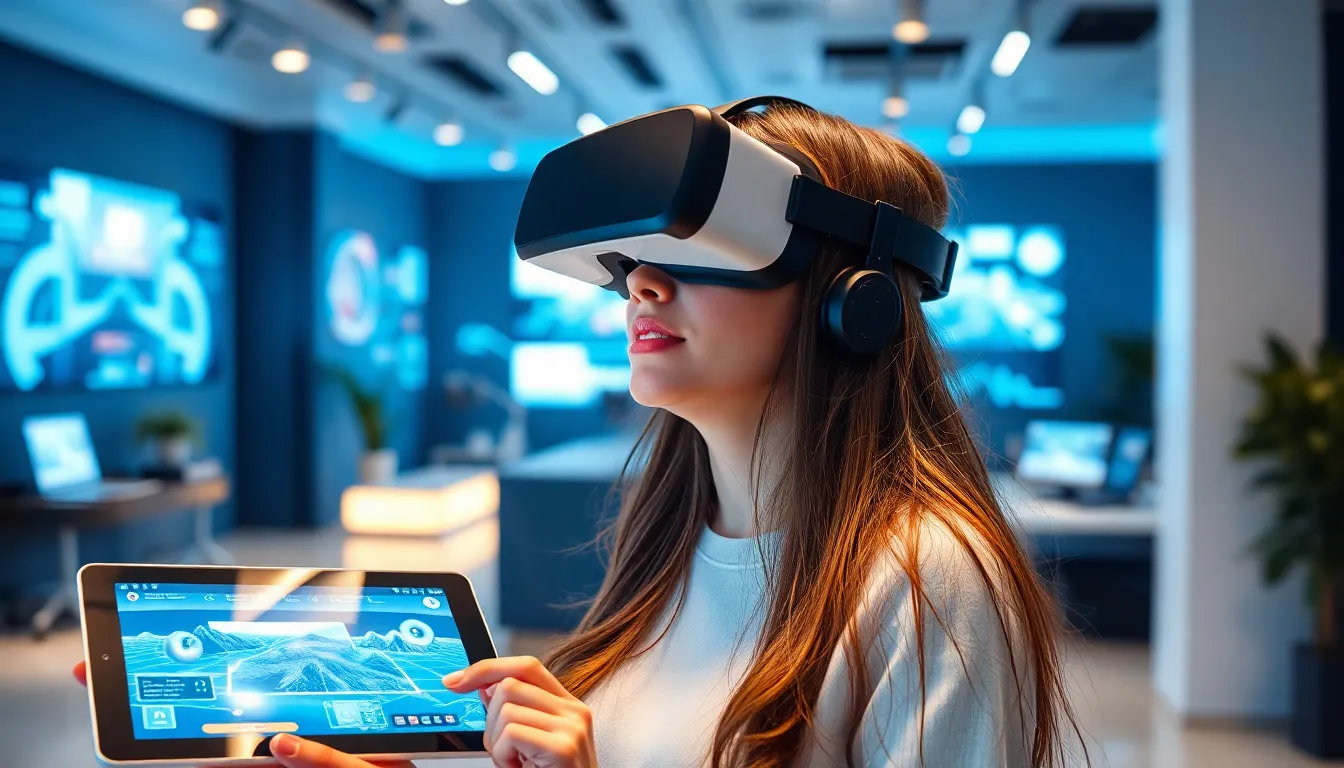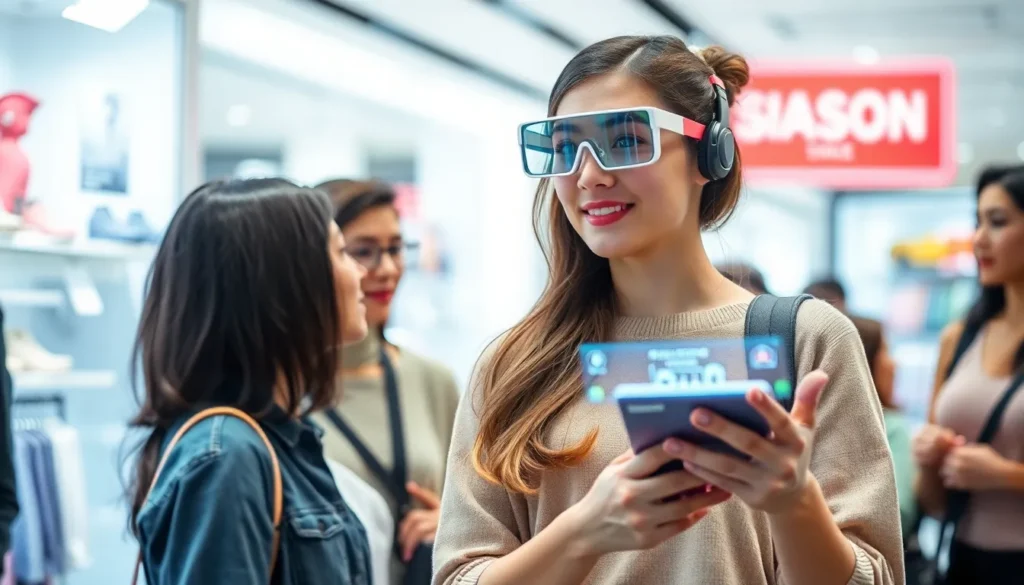Table of Contents
ToggleImagine walking through a mundane grocery store and suddenly seeing animated cereal mascots dancing down the aisle. Welcome to the world of augmented reality, where the ordinary transforms into the extraordinary! As technology leaps forward, augmented reality trends are reshaping how people interact with their environments, blending the digital and physical worlds in ways that were once the stuff of sci-fi dreams.
From enhancing shopping experiences to revolutionizing education, AR is no longer just a novelty. It’s becoming a vital tool across industries. Companies that embrace these trends aren’t just keeping up; they’re setting the pace. So grab your virtual goggles and get ready to explore the cutting-edge developments that are making augmented reality the hottest topic on the tech scene today. Who knew the future could be this fun?
Overview of Augmented Reality Trends
Augmented reality (AR) continuously influences various sectors, illustrating its expanding significance. Notably, innovative applications and developments showcase AR’s potential.
Definition of Augmented Reality
Augmented reality blends digital content with the real world, enhancing user experiences. This technology overlays information or images onto physical environments, using devices like smartphones and AR glasses. AR differs from virtual reality, which immerses users in a fully digital space. Popular examples of AR include mobile games and interactive marketing campaigns. Businesses leverage AR for improved customer engagement, turning ordinary experiences into interactive adventures.
Brief History and Evolution
The journey of augmented reality began in the 1960s with the invention of the first head-mounted display. Early innovations paved the way for advancements in the 1990s, when AR applications emerged in military training and medical fields. By the early 2000s, AR gained traction in consumer electronics, marking its entry into gaming and mobile applications. The rise of smartphones propelled AR into everyday life, exemplified by apps like Pokémon Go. Recent years have seen exponential growth, as companies across different industries adopt AR technologies for diverse purposes, ranging from education to retail.
Current Augmented Reality Trends

Augmented reality continues to evolve, with significant trends shaping its future across various sectors.
Enhanced Mobile AR Experiences
Enhanced mobile AR experiences captivate users by blending digital elements with their surroundings. Users interact with virtual objects through high-quality overlays on smartphones. Companies invest heavily in app development that integrates AR features, leading to enriched shopping experiences and gamified learning. For instance, retailers like IKEA offer apps allowing customers to visualize furniture in their homes. Gamification also supports brand engagement, increasing user retention and loyalty. Enhanced user interfaces ensure seamless interactions, contributing to widespread mobile AR adoption.
Integration with Social Media Platforms
Integration with social media platforms revolutionizes how users share experiences. Popular apps like Snapchat and Instagram incorporate AR filters, enabling users to modify their appearance and surroundings in real-time. Brands utilize these features for targeted marketing campaigns, making promotional content interactive and engaging. This integration leads to increased user interaction and connection with products. Recent statistics show that 70% of consumers are inclined to engage with AR content on social media. Companies recognize this trend, investing more resources into AR technology to enhance user engagement and brand visibility.
Industry Applications of Augmented Reality
Augmented reality is significantly transforming various industries, driving innovation and enhancing user experiences. Key sectors benefiting from AR technologies include retail, education, and training.
Retail and E-Commerce Innovations
Retailers leverage augmented reality to create interactive shopping experiences. Customers can visualize products in their homes before making a purchase, leading to increased satisfaction. Companies like IKEA use AR apps to showcase furniture in real-time, allowing users to see how items fit in their spaces. Statistics reveal that 61% of consumers prefer shopping at stores that offer AR experiences. This technology facilitates personalized customer engagement, fostering brand loyalty. Retailers experience a reduction in return rates due to improved product visualization, directly impacting sales.
Education and Training Enhancements
Augmented reality is revolutionizing education and training by providing immersive learning experiences. Students engage with virtual elements, making complex subjects more accessible. For instance, medical students can practice surgery using AR simulations, significantly enhancing their skills before entering real operating rooms. Research indicates that AR in education increases retention rates by 75%. Training programs for employees also benefit from AR technology, enabling interactive simulations and hands-on experience in a safe environment. Organizations report enhanced training efficiency and reduced costs as a result of implementing augmented reality solutions.
Future Predictions for Augmented Reality
Augmented reality is gearing up for monumental shifts in technology and market presence. The advancements promise to enhance interactivity and user experience across various sectors.
Technological Advancements on the Horizon
Emerging technologies are set to revolutionize augmented reality experiences. Enhanced hardware, such as AR glasses with improved optics, will offer clearer visuals and more comfortable wear. Advances in computational power will enable seamless tracking and interaction with 3D objects in real-time. Additionally, integration with artificial intelligence will facilitate smarter AR applications that adapt to user preferences. Companies investing in machine learning will enhance image recognition, resulting in more accurate overlays. Emerging 5G networks will minimize latency issues, creating smoother experiences. These technological enhancements pave the way for more immersive environments that captivate users.
Potential Market Growth and Impact
Market projections indicate a substantial growth trajectory for augmented reality. The AR market could reach $198 billion by 2025, reflecting an annual growth rate of 43%. Retail industries are poised to leverage AR solutions, with 61% of consumers indicating a preference for shopping experiences enhanced by this technology. In education, predictive analytics suggest that AR applications could boost retention rates by 75%, highlighting their educational efficacy. Industries are preparing to invest significantly in AR training solutions, resulting in more efficient workforce development. Organizations adopting AR technologies will likely position themselves ahead of competitors, enhancing user engagement and brand visibility.
The future of augmented reality is undeniably bright as it continues to reshape various industries. With advancements in technology and increasing consumer demand, AR is transitioning from innovative concept to integral tool. Businesses that embrace these trends are not just enhancing user experiences but also positioning themselves for long-term success.
As AR evolves, its applications will become more sophisticated and widespread, further enriching everyday interactions. The ongoing investment in AR technology signifies a commitment to innovation that will likely yield exciting developments in the years to come. Embracing AR now is essential for companies looking to stay ahead in an ever-changing digital landscape.







